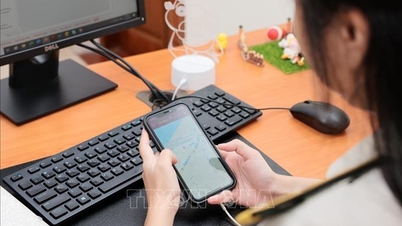Recently, a video of realistically crafted silicone fingers has amazed netizens and quickly spread across TikTok, reaching 121 million views. Every vein, skin color, and even the hand pattern is recreated so meticulously that it is difficult to distinguish it from a real hand. Behind that "stormy" video is the story of two Hanoi boys who quietly spent their youth "shaping" silicone fingers, giving confidence to people with disabilities.
From lifeless pieces of silicon, they create artificial hands, feet, even noses and eyes so sophisticated and real that they bring tears to the wearer's eyes. For them, it is not just a replacement, but an emotional journey, a story of people who yearn to regain their confidence.



Silicone hands and noses for the disabled.
Regaining Confidence for the Disabled
The people who made those prosthetic body parts are Mr. Tran Huy Hiep (36 years old), who used to be a laboratory technician at a large hospital in Hanoi , and Mr. Dao Van Phuc (46 years old), a former student of Biotechnology at Hanoi University of Science and Technology, who also had their own career paths before turning to a new direction - making prosthetic body parts from silicon.
The fate of this job began when Hiep was concerned about the difficulties of people who lost fingers and hands due to accidents or diseases. At that time, the price of cosmetic products bought from abroad was too high. “I thought, why don't I try to find a way to make a product that is both realistic and affordable for people in the country?” , Hiep recalled.
When he shared his plan, Phuc decided to join him. The two began to experiment and learn, from simple fingers to complex products such as feet, ears, noses, and eyes. After nearly ten years in the profession, they have proven that their seemingly reckless choice was the right one.
The process of making a prosthetic is not simple. First, you have to take a sample, measure the size, record every small detail such as wrinkles, fingerprints, and finger curvature. Then, you have to create a wax model, adjust it to fit as best as possible, and then go to the silicon casting stage. The time to complete each product usually lasts from 15-30 days.



The new ears were revived as if they were real.
" The most meticulous step in making a silicone prosthetic is mixing the color; not only does it need to be 90-95% similar to real skin color, but it also needs to match the rest of the body. If the color of a finger is slightly different, it will be easily revealed." Mr. Hiep shared.
The special thing about Hiep and Phuc's facility is that all products are made directly from AZ, without intermediaries. Thanks to that, they are proactive in every step, from sampling, molding to color mixing and finishing. Initially, the two brothers only experimented with simple fingers. Gradually, the research process expanded to more complex products such as noses, eyes, hands or feet.
Prosthetic eyes are considered the biggest challenge. Unlike other parts, the eyes are directly related to the pupils, eyeballs and even the spirit. While fingers or hands can cover the edges in many ways, the eyes hardly allow any mistakes. Currently, the realism of the prosthetic eye product is about 70%, although not low, it is still a big challenge that the team is trying to overcome.
The cost of making a prosthetic eye is not low, ranging from 20 to 40 million VND depending on the specific condition of the customer. More than a matter of money, this is a journey to regain confident vision for the less fortunate.

Make prosthetic eyes for people with eye defects.


Fingers and toes through the hands of two talented craftsmen.
Each product is a life story
According to Tran Huy Hiep and Dao Van Phuc, the hardest part is not the technique, but understanding the customer's story, because behind each order is a tragedy, an inferiority complex. There is a worker who lost a finger in a work accident. There is a young girl with a birth defect, always hiding her hand in her pocket. There is an old man who just wishes he had his hand back so he could hold his grandchild without being looked down upon...
Their first customer for a prosthetic nose came to them in 2019. This person lived in Ho Chi Minh City, had an accident as a child, underwent 14 surgeries and lost all of her nasal cartilage. Her unique appearance prevented her from getting a job even though she had graduated from university. After receiving the silicone nose, the girl shed tears of joy: “I regained the confidence to go out into society and get hired for my dream job."
Phuc and Hiep’s customers are not only Vietnamese. There was a Thai customer who flew to Hanoi to get a prosthetic hand made to prepare for his wedding. Some people in Europe and the Middle East also sent requests from afar, because the cost of making prosthetics at this facility is only a small fraction of the cost of similar products in their countries.
“Many customers burst into tears when receiving their silicone prosthetics. Some tried the product on and held hands with their loved ones, smiling happily. That is the greatest spiritual value for us.” Hiep confided.
One of the special customers who are close to Mr. Hiep and Mr. Phuc is the young actor Pham Tuan Dung (23 years old). Dung lost four fingers at the age of 4, after playing with a cutting machine and getting an infection, forcing the joint to be amputated. The physical pain passed, but the inferiority complex remained throughout his childhood. When he learned that physical disability was one of the barriers to entering art school, Dung was extremely sad and self-conscious.
The young actor recalls: "During those uncertain days, I accidentally searched on Google and found information about a facility specializing in making fake silicon limbs. At that time, the facility had just opened, I sold my old motorbike for 600,000 VND, which was all my capital, and brought that small amount of money to find it. Luckily, I became one of the first customers and was able to take a finger sample."
The moment he tried on the finished silicone fingers, Dung was moved to tears, feeling as if he had a lost part of his body back. Thanks to those four fingers, he regained his confidence and passed the entrance exam to the Central Art Pedagogy School.
Until now, even though he was given a new set of silicone fingers, Dung still keeps and wears the first set as a special souvenir. “Without them, I wouldn't be who I am today,” The actor shared. He has participated in a number of TV series such as Doc Dao, Di Giua Troi Ruc Roi… , although only assigned small roles, are still the clearest proof of the will to overcome inferiority complex, with the silent support of the silicone hands created by Mr. Hiep, Mr. Phuc and their colleagues.



Actor Pham Tuan Dung has four new silicon fingers.
Overcome barriers, keep your wishes
The products of two Hanoi craftsmen have created a stir not only in Vietnam; videos recording the manufacturing process and the results shared on TikTok and YouTube quickly went viral, most of them reaching millions of views. One clip reached more than 121 million views, a number that surprised even them.
“We don’t run ads, everything spreads completely naturally. 70% of foreign customers come from TikTok, 20% from YouTube and the rest through the website,” Mr. Phuc said.
Thanks to the power of social networks, international customers are increasing. From Asia, Europe to America, many people place orders or go directly to Vietnam to do it. This proves that Vietnamese skills are completely on par with the world , while the cost is many times cheaper. In Europe, a fake finger can cost more than 2,000 USD (over 50 million VND), in Japan about 70 million VND, and in Vietnam, the price of this product is only from 1-3 million VND.


Two workers always keep in mind to bring the best to customers.
In addition to serving customers with disabilities, their silicone products are also ordered for the film industry, especially horror films or films that require prosthetics. Scars and bloody hands on film sometimes come from this small workshop in Hanoi.
Despite their success, their journey was not easy. Raw materials had to be imported, and there was no formal training for the profession, so they had to figure it all out on their own. Many times they failed, many details could not reach the desired level, so they had to throw them away and start over.
“We believe that a product is not just an item but a bridge to bring disabled people back to normal life. That is true success,” Hiep said.

Mr. Hiep and Mr. Phuc prove that Vietnamese people's ability in the field of making silicone prosthetics is not inferior to foreign countries.
Both of them always maintain the viewpoint that the price must be as reasonable as possible for many people to access. With that goal, they created a remote sampling kit, helping customers avoid costly travel while still having the right product. Difficult cases such as students, the elderly or poor patients are often supported or made at minimal cost.
Source: https://baolangson.vn/doi-ban-ha-thanh-bien-silicon-thanh-da-thit-cho-nguoi-khiem-khuet-5061426.html


![[Photo] Unique Phu Gia horse hat weaving craft](https://vphoto.vietnam.vn/thumb/1200x675/vietnam/resource/IMAGE/2025/10/10/1760084018320_ndo_br_01-jpg.webp)
![[Photo] Opening of the World Cultural Festival in Hanoi](https://vphoto.vietnam.vn/thumb/1200x675/vietnam/resource/IMAGE/2025/10/10/1760113426728_ndo_br_lehoi-khaimac-jpg.webp)
![[Photo] Ho Chi Minh City is brilliant with flags and flowers on the eve of the 1st Party Congress, term 2025-2030](https://vphoto.vietnam.vn/thumb/1200x675/vietnam/resource/IMAGE/2025/10/10/1760102923219_ndo_br_thiet-ke-chua-co-ten-43-png.webp)






























































































Comment (0)